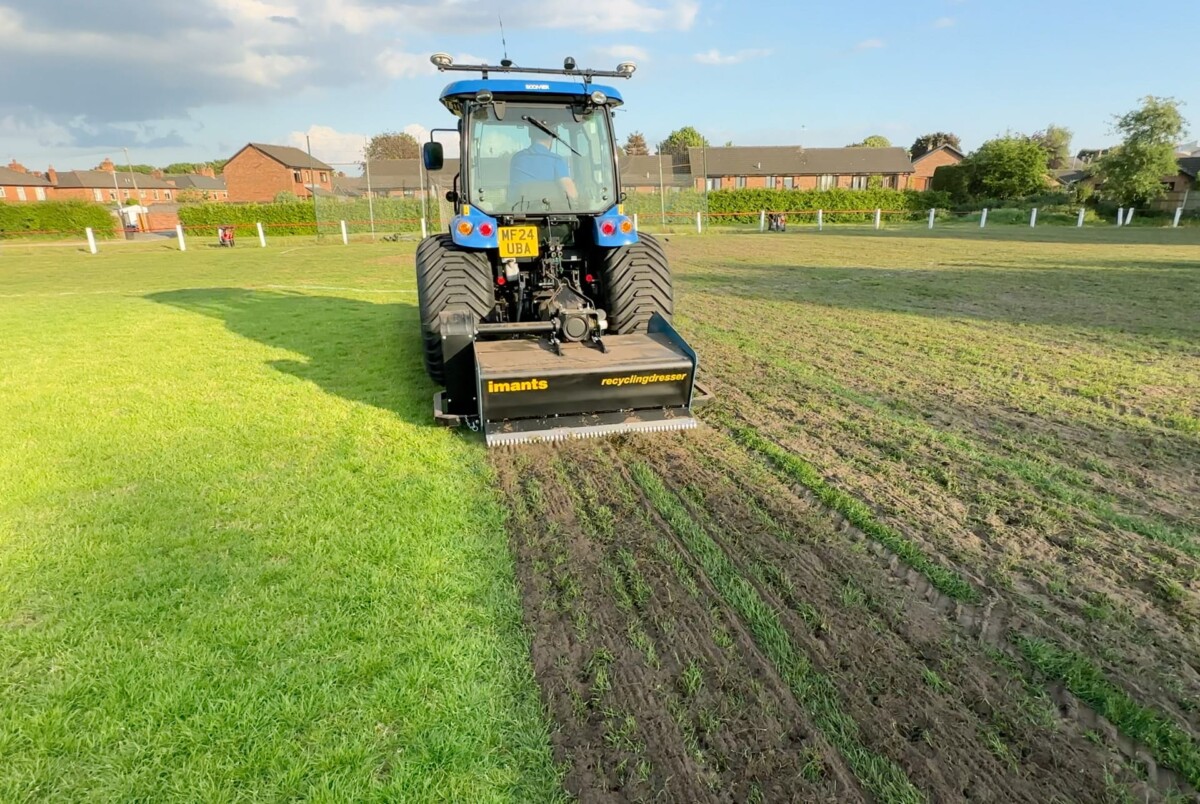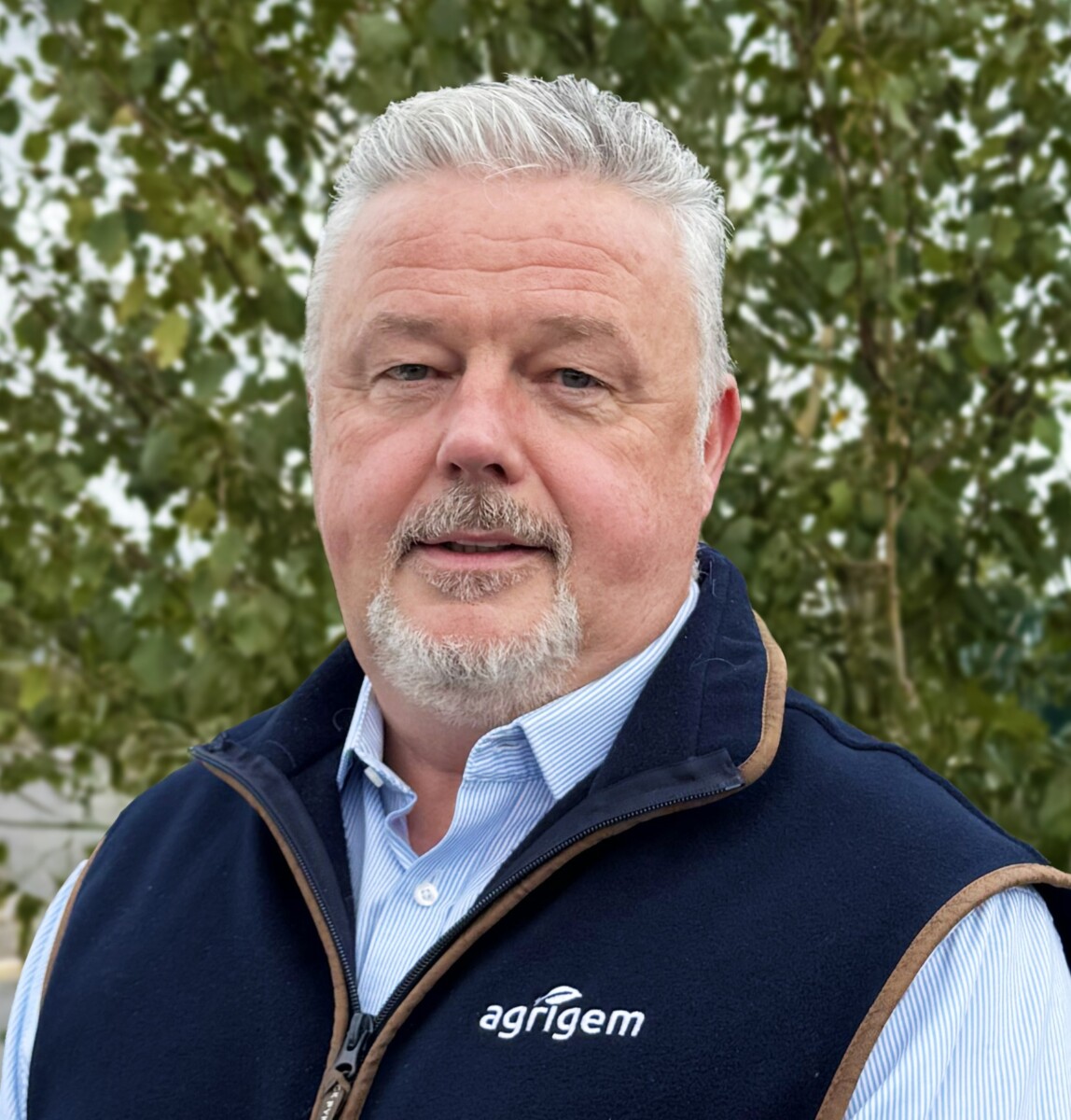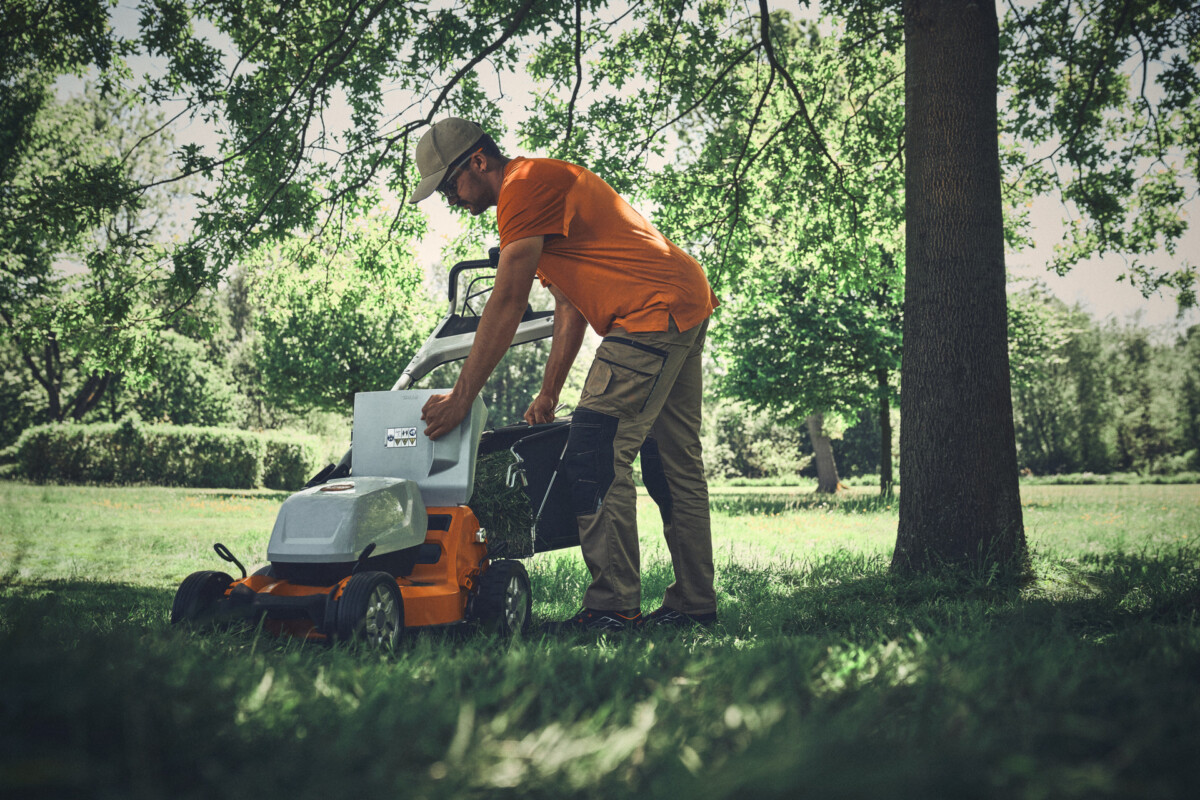Threat to our golfing jewels: As weather becomes more extreme, coastal erosion is an issue for just about every links golf course in the country. What can and should be done? Scott MacCallum reports.
At the risk of sounding like John Lennon. Imagine there’s no Wembley; no Aintree Race course too. Imagine there’s no venues, it isn’t hard to do.
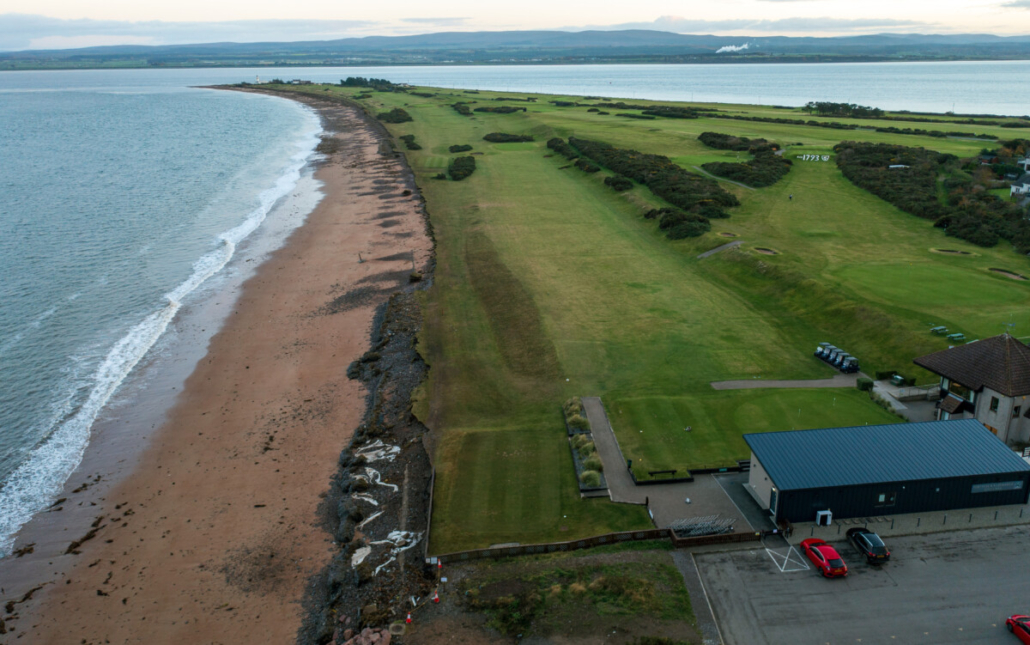
Threat to our golfing jewels
You get my drift. What if Wembley and Aintree, along with the likes of Wimbledon, Lords and Murrayfield, just disappeared off the face of the earth?
Sounds implausible doesn’t it? You might even accuse me of being a dreamer. But I’m not the only one. That’s the fate facing some of the country’s oldest and most revered golf courses, as coastal erosion has seen increasingly large chunks of links land being reclaimed by the sea.
The list of courses is as worrying as it is long. It includes Royal Aberdeen GC, which has hosted a Walker Cup, a Scottish Open and a British Seniors Open; Royal Montrose Golf Links, the fifth oldest golf course in the world; Alnmouth Village Golf Club, England’s oldest nine hole links course; Fortrose Golf Links, the 15th oldest golf links in the world.
Not to mention the hallowed St Andrews Links where intervention work has been going on for a number of years. That’s home to the Old Course, the most famous golf course in the world!
There is an army of modern day King Canutes, in the guise of Course Managers, facing the challenge of nature, with no guarantee that the resources or solutions are available to avoid the inevitable.
In fact, research shows that 100 Scottish golf courses are facing, or will be facing, the impact of coastal erosion with many historical and outstanding English courses facing the prospect of course damage, including Royal North Devon in the south and Formby and West Lancs in the north west.
New data has identified the courses that are most at risk from the effects climate change and while some of the timelines appear to give a decent amount of warning, there is no guarantee that solutions will resolve the issues.
Betting odds company AceOdds studied data, provided by Statista, which shows that the UK’s sea level is expected to rise by up to half a metre by the turn of the century.
It is reckoned that up to 28% of coastline in England and Wales, and 19% in Scotland, is at risk of erosion and, with a significant proportion of the country’s courses on low-lying ground where the land meets the sea, the dangers are there for all to see.
They found that the courses used by Arbroath Golf Club and Leven Golfing Society have a ‘high-risk’ level of flooding from both surface water and river/sea water, sitting only 24 metres and 35 metres above sea level on average.
That gives both a 75% ‘erosion risk’ over the next 75 years.
In England, Formby Golf Club is the course most at risk from climate change. It sits five metres above sea level and has a high risk of flooding from surface water, with a 50% likelihood of experiencing coastal erosion in the next 75 years.
Other highly regarding courses facing varying degrees of risk include Royal Dornoch, Nairn, Moray and the aforementioned West Lancs.
But for some the impact has come much quicker than anticipated and the results are horrific.
Fortrose and Rosemarkie Golf Club, on Scotland’s Black Isle, would have architect, James Braid, spinning in his grave if he knew what the golf course he laid out was now facing.
Last October it was visited by Storm Ciaran, which coincided with a high tide and historically low atmospheric pressure, and it created more havoc in the space of one night that the club had experience in many many years.
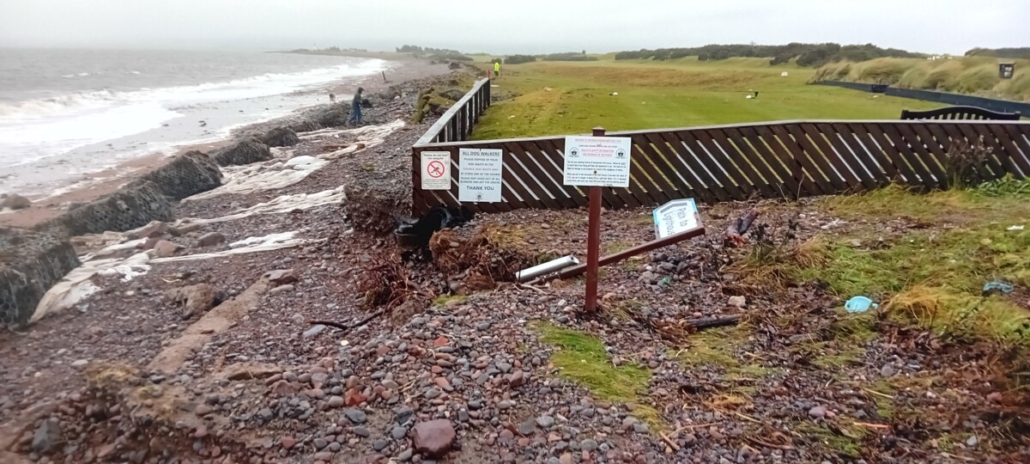
Massive waves washed away between five and six metres of land, with the 1st and 2nd holes particularly impacted.
Club Manager Mike MacDonald told Michael McEwan, of Bunkered magazine, that the club was aware if the issues and had begun making plans.
“Towards the end of 2022 we set up a coastal erosion sub-committee and throughout 2023 we met with various representatives from the Highland Council and Scottish Water to highlight the issues we were facing,” Mike told Bunkered.
However, they got very little support from either body, while other attempts to source funding from national bodies were turned down.
“So it wasn’t a surprise that we were impacted. What was surprising was the extent of the damage. It was far more severe and devastating than any of us had anticipated.”
The club has already used rock armour to reinforce the area around the 1st and 2nd, but it is a costly option leaving the club with a bill for £140,000 just for this one defence for one part of the golf course.
With little or no support coming from outside, the club is resorting to crowd funding and while this has produce some very welcome results it is but a drop in the ocean of what will ultimately be required.
Course Manager, George Paterson, is the man at the sharp end trying to keep the elements at bay.
George is a big fan of soft defences, rather than the rock armour which, while it has its place, does tend to shift the problem down the coast.
“We reclaimed 2850 tonnes of sand/Marram mix from the far end of the beach and established a dune area above the high tide watermark. It took three days and roughly 95 loads in a 30 tonne dump truck,” George told Turf Matters.
“This was banked up along the 250 metre eroded stretch of beach at the 1st hole and then we installed 500 metres of chestnut fencing to help stabilise the sand and keep foot traffic off it.
“This was done in March of this year, but a high tide in early April took away about three to four metres of the sand and we had to re-stake some of the fencing.
Since then it has re-stabilised and the sand has started to gather at the foot of the fencing again.
“Inside the fenced area, and along where our red hazard posts and public footpath are, we have sewn out a mix of creeping ryegrass and creeping fescue which is now starting to take hold.”
The issue at Fortrose is the same as at many similarly threatened links courses – there is no option of re-routing as the additional land just isn’t available.
Montrose Golf Links lost seven metres of golf course in the last 12 months, having foreseen a loss of perhaps one or one and a half metres a year prior to that.
They actually moved the 3rd tee in 2017 but that has already disappeared and the half a million they have allocated to improving defences may only prove to be a sticking plaster solution.
South of the border, but not that far south, is Alnmouth Village Golf Club, in Northumberland, England’s oldest nine hole links course.
A vibrant golf club with 300 members it is all that is good about small golf clubs. When I visited an army of members were just completing a divotting session led by Head Greenkeeper, John Scurfield, and Club Secretary Ian Simpson.
Once they had finished their divoting stint they took me out to the 5th hole which had taken a battering late last year. The traffic cone marking the current edge between green and beach is a stark indicator of the power of nature.
The course may have suffered even more if it wasn’t for the concrete blocks that were installed as tank defences during the war.
They have done a remarkable job to holding back the tide but there was a gap of 100 yards between them, a gap which exposed the 5th.
There would have been no extensive planning process required to keep Hitler at bay, but in 21st century Britain that isn’t the case, and Ian had been told informally that any hard – rock armour – defence option would not survive the planning stage.
“If we could have moved some tank blocks or put some more in it might be able to slow the erosion down,” explained Ian.
“Long term we are probably going to have to move the 5th green, 40 to 50 yards left of where it is now.”
When we were there the tide was out but the spring tide comes right up to the edge and John has to remove seaweed from the top of tee boxes.
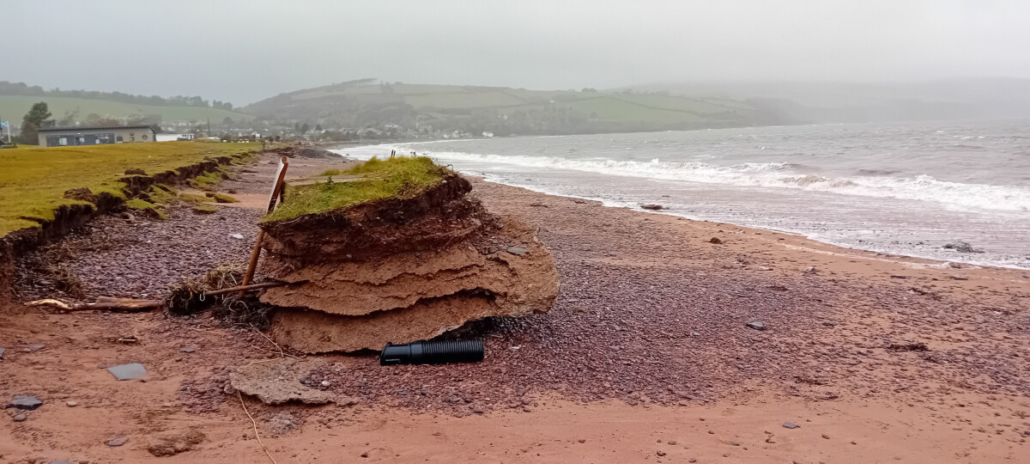
Tide is out water does come right up to the edge can see the seaweed line can see how high the tide comes. Recently not so high tides come springtime and spring tides right up agains the edge, combined with an easterly wind.
“You can feel the spray when you are out working on the course,” said John.
He arrived as Head man just before the latest erosion issue.
“I was a little bit worried that my place of work disappearing before my eyes, especially after always considering it one of the driest golf course in the north east of England,” said the man who was fulfilling a wish to work on a sand golf course rather than having constantly to be kicking mud off his wellies.
He has some longer term ideas which may help the golf course in a number of ways.
“The 6th hole is a blind uphill hole which is not idea for cutting from my perspective nor from a health and safety perspective for players. Ultimately we could move a few thousand tonnes of sand and reduce the height of the hole and flatten it out.”
It is great to see such positivity in a tricky situation but those potential solutions are not for the immediate future and hoping the weather is kind, and the next spring tides are not too severe, are key to the course avoiding any more damaging events.
Ian is currently waiting to see what options emerge so that financial targets can be set and fund raising campaigns put in place.
So what’s happening at golfing HQ in St Andrews.
Well, the R&A is aware of the issue, and back in 2020 invested up to £650,000 to fund golf course sustainability projects.
That amount wasn’t ring fenced for coastal erosion, but also covering green quality and general agronomic projects.
The R&A did however commission an Aberdeen-based company, Siskin Asset Management, who had submitted a proposal for a demonstration project of their new concept.
Traditionally, durable defence against erosion is based on hard engineering. In place of this Siskin had developed a concept based on well recognised soft engineering techniques. These techniques have been enhanced to improve durability and resilience in common coastal conditions.
This delivers mitigation of erosion at a lower up front cost and reduced lifecycle cost while being deployable using only community level resources.
Being based on soft engineering methods the concept also has a low environmental footprint.
The method uses a by-product of forestry operations called brash, akin to old Christmas trees. This natural product is baled before being arranged in a defined geometry and anchored in the back beach area of soft coastlines.
This structure then acts to capture mobile sediment and promote re-vegetation of the existing coast.
The overall effect being to enhance the resilience of the coastline against wave and wind attack.
After assessing the project the R&A agreed to support and approved funding accordingly. Both the R&A’s and Siskin Asset Management’s websites carried the same information:
The planned demonstration project is targeting the installation of the novel system along an approx. 100m section of coastline currently suffering from erosion. Once installed the demonstration site will be monitored as part of a three year PhD project to evaluate system effectiveness and provide learning. Information gathered during the demonstration project will be disseminated via update reports, conferences and standard media channels.
That was back in 2020 and while Covid will undoubtedly have slowed progress on what was to be a three year PHD project, there has been no further updates on either of the websites.
I was told that the R&A was still awaiting the report from that research and that it might not be until next year before that changes.
To date, and to the best of my knowledge, no information gathered during the project has been shared by Siskin Asset Management.
With time of the essence for so many of golf’s crown jewels we do need some urgency, some joined up thinking and some leadership from those with the power to provide it.
Nature is a powerful foe but the thought of accepting defeat and seeing some of our classic links disappear would be too much to bear.
To misquote the Beatles once again…
Yesterday
All our troubles seemed so far away
Now at looks like they’re here to stay
We can only hope not, and that golf clubs like Fortrose & Rosemarkie, Alnmouth and so many others are not left out in the cold attempting to stem the tide at a cost many of them will struggle to afford.













